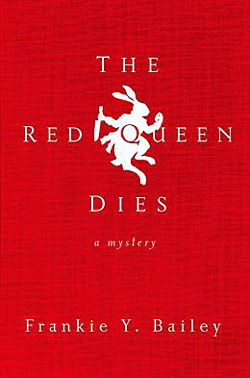 The Red Queen Dies by Frankie Y. Bailey is the debut mystery featuring Detective Hannah McCabe—who works in an alternate near-future of Albany, New York in 2019—hunting a serial killer who seems connected to Alice in Wonderland (available September 10, 2013).
The Red Queen Dies by Frankie Y. Bailey is the debut mystery featuring Detective Hannah McCabe—who works in an alternate near-future of Albany, New York in 2019—hunting a serial killer who seems connected to Alice in Wonderland (available September 10, 2013).
Frankie Y. Bailey is the author of nonfiction about crime and detective novels as well as the Lizzie Stuart mysteries, featuring a historian of crime. She begins a new series with The Red Queen Dies, a blending of near-future science fiction with procedurals, as police detective Hannah McCabe searches for a serial killer. Along the way, Bailey introduces futuristic technology and explores how its use might affect law enforcement from a number of different perspectives, both for the police and for average citizens.
Bailey’s mingling of past and future police methodology adds pops of interest throughout, especially when contrasted with police work that doesn’t appear to have changed much from the way it is today.
In a half squat, McCabe drew her weapon and fired. Her bola wrapped around the man’s legs. He sprawled forward, entangled in the cords, crashing into moldering cardboard boxes and other garbage. McCabe ran toward him. He twisted onto his side, trying to sit up and free himself. “Get these ropes off me, bitch!”
“Stay down,” she said, training the weapon, now set to stun, on the perp’s scrawny torso. “Roll over on your belly.” He looked up at her face, then at the gun. Either he was convinced she would use it or deterred by the minicam that was attached to the weapon and was recording their encounter.
Resonating with current events, technology and surveillance have become an even larger part of police work as well as daily life. But as we already experience today, the technology is far from foolproof, leaving plenty of room for the human investigators. Technology has limits, and the bureaucracy meant to support both the advanced technology and those who use it sometimes fails.
McCabe and Lieutenant Dole had joined Pete Sullivan in the Communications Center. The center was home to the 911 system. It also housed the interfaces for the surveillance cameras that watched what was happening in the city twenty-four hours a day, seven days a week and for the sensors that registered the sounds of gunfire or explosions and pinpointed the locations.
…
“We have cameras in both places. But they went down a couple of weeks ago, after the solar flares.”
“And they haven’t been fixed?” McCabe asked.
“The techs have the ones on the inhabited portion of Delaware and the side streets back online. The others on the bridge are on the list,” Sullivan said. “In case you missed it, the budget increase we asked for hasn’t been approved yet.”
“Sorry,” McCabe said. “I didn’t mean—”
“We’re going to get all kinds of blowback on this one.” Sullivan tugged at his mustache. “Vivian Jessup, and the damn cameras are out. Nobody’s going to take into account that we’ve got equipment all over the city to keep functioning. Priority goes to maintaining and enhancing coverage of those areas where we’ve got people and property to protect.
However, Bailey never lets the technology take over from the human element of the story. Though advances in science provide additional clues, the criminal is human, and in the end it’s McCabe who must decide which evidence is relevant to the crime, and explore avenues that might not seem obvious. She and her partner, Baxter, make connections among seemingly disparate fragments of information; though they have the help of a research department and vast amounts of computer records, their own experience and processing power is needed to speculate on human motives related to the facts they uncover. In addition, McCabe’s family, in particular her retired journalist father, Angus, add complicated emotional ties that sometimes interact with her work.
The Red Queen Dies is a fascinating commentary on police procedure and where it might be heading in the future.
To learn more or order a copy, visit:
opens in a new window![]() opens in a new window
opens in a new window![]() opens in a new window
opens in a new window![]()
opens in a new window![]() opens in a new window
opens in a new window![]() opens in a new window
opens in a new window![]()
Victoria Janssen is the author of three novels and numerous short stories. She also reads a lot. Follow her on Twitter: @victoriajanssen or find out more at victoriajanssen.com.

I’m really looking forward to reading this book!